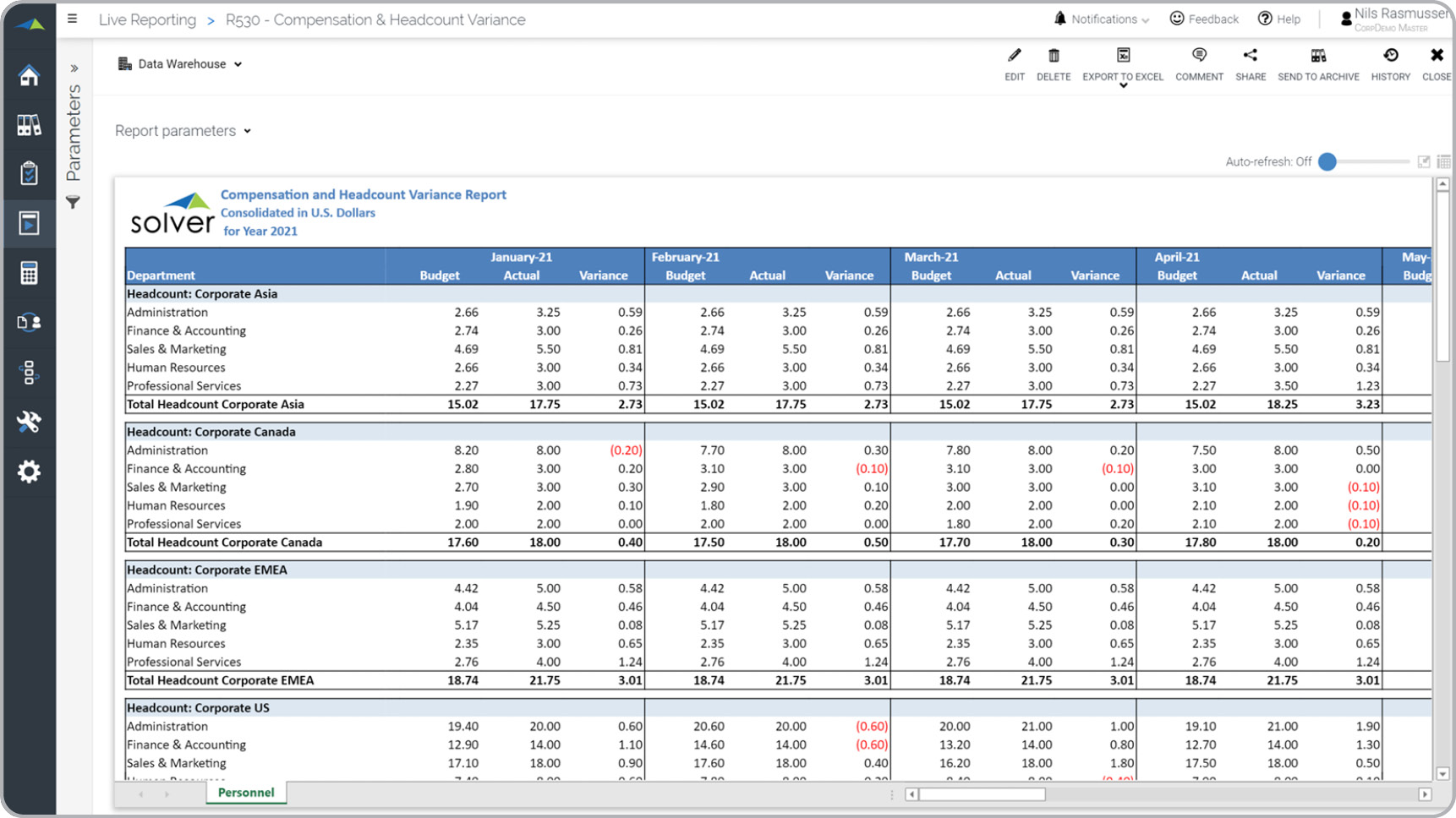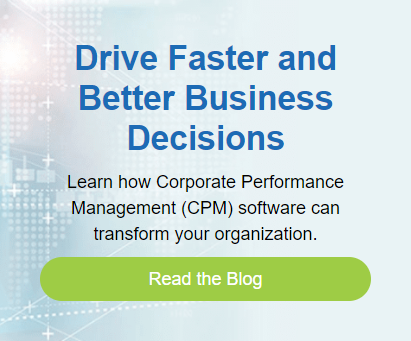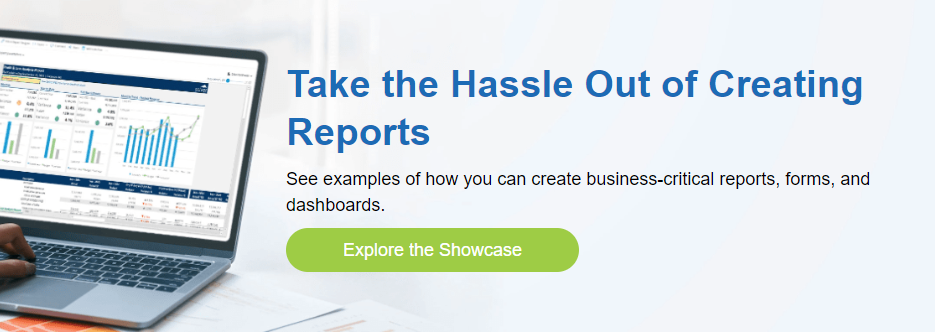Related Posts
BLOG HOME
- Top 50 Opportunities Report for SaaS Companies using Dynamics 365 BC
- Subscription Sales by Contract Length Report for SaaS Companies using Dynamics 365 Business Central
- Lead Target Model for SaaS Companies using Dynamics 365 Business Central
- Cap Table Template for SaaS Companies using Dynamics 365 Business Central
- Rolling 12 Month Cash Balance Report for SaaS Companies using Dynamics 365 Business Central
Compensation & Headcount Variance Report
What is
a
Compensation & Headcount Variance Report
? Salary and Full-time Equivalent (FTE) reports are considered employee or HR reports and are often used by HR and other managers to get a complete overview of headcount and compensation status versus plan. Some key functionality in this type of report displays actual and budget FTE figures per department and division for each month of the year. It also shows (not visible in the screenshot below) total compensation per department along with variance from plan. You will find an example of this type of report below.
Purpose of
Compensation & Headcount Variance Reports Companies and organizations use Compensation & Headcount Variance Reports to get a complete month-by-month overview of number of staff members and related compensation costs compared to the budget for the year. When used as part of good business practices in a Human Resource (HR) department, a company can improve its ability to track results of recruiting and retention efforts, and reduce the chances that any important exceptions versus originally planned FTEs and salary expenses are missed.
Compensation & Headcount Variance Report
Example Here is an example of a detailed Compensation and Headcount Variance report. [caption id="" align="alignnone" width="1722"]
 Compensation & Headcount Variance Report Example[/caption] You can find hundreds of additional examples
here.
Who Uses This Type of
Report
? The typical users of this type of report are: HR and Payroll Managers.
Other
Report
s Often Used in Conjunction with
Compensation & Headcount Variance Reports Progressive Human Resource (HR) department Departments sometimes use several different Compensation & Headcount Variance Reports, along with salary and employee reports and dashboards and other management and control tools.
Where Does the Data for Analysis Originate From? The Actual (historical transactions) data typically comes from enterprise resource planning (ERP) systems like: Microsoft Dynamics 365 (D365) Finance, Microsoft Dynamics 365 Business Central (D365 BC), Microsoft Dynamics AX, Microsoft Dynamics NAV, Microsoft Dynamics GP, Microsoft Dynamics SL, Sage Intacct, Sage 100, Sage 300, Sage 500, Sage X3, SAP Business One, SAP ByDesign, Acumatica, Netsuite and others. In analyses where budgets or forecasts are used, the planning data most often originates from in-house Excel spreadsheet models or from professional corporate performance management (CPM/EPM) solutions.
What Tools are Typically used for Reporting, Planning and Dashboards? Examples of business software used with the data and ERPs mentioned above are:
Compensation & Headcount Variance Report Example[/caption] You can find hundreds of additional examples
here.
Who Uses This Type of
Report
? The typical users of this type of report are: HR and Payroll Managers.
Other
Report
s Often Used in Conjunction with
Compensation & Headcount Variance Reports Progressive Human Resource (HR) department Departments sometimes use several different Compensation & Headcount Variance Reports, along with salary and employee reports and dashboards and other management and control tools.
Where Does the Data for Analysis Originate From? The Actual (historical transactions) data typically comes from enterprise resource planning (ERP) systems like: Microsoft Dynamics 365 (D365) Finance, Microsoft Dynamics 365 Business Central (D365 BC), Microsoft Dynamics AX, Microsoft Dynamics NAV, Microsoft Dynamics GP, Microsoft Dynamics SL, Sage Intacct, Sage 100, Sage 300, Sage 500, Sage X3, SAP Business One, SAP ByDesign, Acumatica, Netsuite and others. In analyses where budgets or forecasts are used, the planning data most often originates from in-house Excel spreadsheet models or from professional corporate performance management (CPM/EPM) solutions.
What Tools are Typically used for Reporting, Planning and Dashboards? Examples of business software used with the data and ERPs mentioned above are:
 Compensation & Headcount Variance Report Example[/caption] You can find hundreds of additional examples
here.
Who Uses This Type of
Report
? The typical users of this type of report are: HR and Payroll Managers.
Other
Report
s Often Used in Conjunction with
Compensation & Headcount Variance Reports Progressive Human Resource (HR) department Departments sometimes use several different Compensation & Headcount Variance Reports, along with salary and employee reports and dashboards and other management and control tools.
Where Does the Data for Analysis Originate From? The Actual (historical transactions) data typically comes from enterprise resource planning (ERP) systems like: Microsoft Dynamics 365 (D365) Finance, Microsoft Dynamics 365 Business Central (D365 BC), Microsoft Dynamics AX, Microsoft Dynamics NAV, Microsoft Dynamics GP, Microsoft Dynamics SL, Sage Intacct, Sage 100, Sage 300, Sage 500, Sage X3, SAP Business One, SAP ByDesign, Acumatica, Netsuite and others. In analyses where budgets or forecasts are used, the planning data most often originates from in-house Excel spreadsheet models or from professional corporate performance management (CPM/EPM) solutions.
What Tools are Typically used for Reporting, Planning and Dashboards? Examples of business software used with the data and ERPs mentioned above are:
Compensation & Headcount Variance Report Example[/caption] You can find hundreds of additional examples
here.
Who Uses This Type of
Report
? The typical users of this type of report are: HR and Payroll Managers.
Other
Report
s Often Used in Conjunction with
Compensation & Headcount Variance Reports Progressive Human Resource (HR) department Departments sometimes use several different Compensation & Headcount Variance Reports, along with salary and employee reports and dashboards and other management and control tools.
Where Does the Data for Analysis Originate From? The Actual (historical transactions) data typically comes from enterprise resource planning (ERP) systems like: Microsoft Dynamics 365 (D365) Finance, Microsoft Dynamics 365 Business Central (D365 BC), Microsoft Dynamics AX, Microsoft Dynamics NAV, Microsoft Dynamics GP, Microsoft Dynamics SL, Sage Intacct, Sage 100, Sage 300, Sage 500, Sage X3, SAP Business One, SAP ByDesign, Acumatica, Netsuite and others. In analyses where budgets or forecasts are used, the planning data most often originates from in-house Excel spreadsheet models or from professional corporate performance management (CPM/EPM) solutions.
What Tools are Typically used for Reporting, Planning and Dashboards? Examples of business software used with the data and ERPs mentioned above are:
- Native ERP report writers and query tools
- Spreadsheets (for example Microsoft Excel)
- Corporate Performance Management (CPM) tools (for example Solver)
- Dashboards (for example Microsoft Power BI and Tableau)
- View 100’s of reporting, consolidations, planning, budgeting, forecasting and dashboard examples here
- See how reports are designed in a modern report writer using a cloud-connected Excel add-in writer
- Discover how the Solver CPM solution delivers financial and operational reporting
- Discover how the Solver CPM solution delivers planning, budgeting and forecasting
- Watch demo videos of reporting, planning and dashboards
Global Headquarters
Solver, Inc.
Phone: +1 (310) 691-5300




